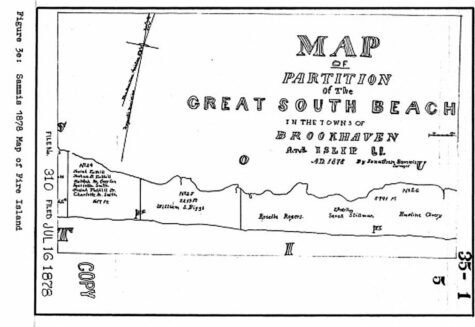
The Cherry Grove Community House and Theater was listed on the National Register of Historic Places in 2013. It carries the additional qualification, “of national significance,” gateway to Landmark status. The research and analysis accompanying the application process was rigorous, similar to a college term paper. Primary source material (an era’s contemporary records, deeds, maps) and secondary sources (e.g. biographies, books written by historians – which may or not be based on primary sources), among other resources, are incorporated into the historic narrative. Cherry Grove’s narrative ranged from its settlement through 1969, the year of New York City’s Stonewall Riots.
Luckily, the Cherry Grove Property Owners Association and the Arts Project had maintained minutes and materials documenting their activities beginning in 1944. These primary source materials formed the backbone of the site’s application.
Not so easily authenticated were the “origin legends” of Cherry Grove itself – when it was established as a settlement. Legend and historians of record say that Archie and Elizabeth Perkinson came to Fire Island in 1868. They built accommodations, a small dock, and began offering food and lodging to hunters and fishermen visiting the Great South Beach. Over time they built a hotel and named their lot Cherry Grove.
The narrative’s accuracy came into question recently when a social media site pointed to a sign inscribed, “Welcome to Cherry Grove, est. 1869.” Commenters endorsed jointly celebrating the 50th anniversary of the Stonewall Inn Riots and the 150th anniversary of Cherry Grove. No one reading the social media column ‘owned’ creating the sign with its 1869 date designation.
Whether or not an anniversary event is held is unimportant. Legitimizing the 1868 date is a valid exercise, however, especially at a time when “alternate facts” (aka personal opinion) trumps available evidence. The goal of historians is to avoid inadvertently creating historical mythologies in pursuit of facts. To cut to the chase, there are no primary source records discovered as yet that conclusively confirm 1868 or 1869 as the founding date of Cherry Grove.
Fire Island in the 1860s was a resort destination that included the David S.S. Sammis Surf Hotel and the Dominy House near the Fire Island Lighthouse on the western end of the island. Steam ferries from Babylon transported visitors to these locales. People traveled by sailboat from Sayville and Patchogue (where the Perkinson family resided) to today’s Cherry Grove. Period newspapers evidence these facts.
Maps from the 1700s indicate lifesaving cabins and rude fishing shacks dotting the Atlantic shoreline. No present day communities are named. “Heads and Horns” is a named location of present day Cherry Grove on 1830’s maps. Beyond such markers, little documentation exists regarding land ownership.
An online report, “Historic Resource Study, Fire Island National Seashore Long Island, N.Y.” (Fletcher and Kintz, 1979), describes disputes over common vs. private land ownership, which characterized Fire Island land use and tenure. An oft-cited primary source is Green vs. [David S.S.] Sammis, as an adjudicated dispute. Regional agencies document that 20 proprietors (freeholders) purchased undivided beach property at Fire Island Inlet in 1789.
Many of the freeholders and heirs never consistently filed deeds or wills with Brookhaven documenting property transfers. Over 100 parties with claims to Fire Island property were notified of a pending partition action in 1871. (Perhaps the Perkinsons were among those.) One of three unbroken chains of ownership belonged to Humphrey Avery whose three granddaughters inherited his Fire Island land part in 1871, subject to the dowager rights of their mother Betsy Avery. That was Lot 26 (the future Cherry Grove) so designated on the Jonathan Sammis (Surveyor) map arising out of the Great Partition of 1871-1878. Neighbors shared their Fire Island lots for cattle grazing and the harvesting of sedge seagrasses. In civil law a “usufruct” is the right granted an individual to use and enjoy the property of another provided they care for and maintain it and/ or pay rent.
It is entirely possible the Perkinsons rented or informally shared a lot, or were unmolested common law tenants of the Avery property for a number of years preceding the Great Partition. Yet to be discovered historic papers might confirm this. Secondary sources do state the Perkinsons bought Fire Island property shortly following the Great Partition settlement (circa 1878).
A turn back time article in the Suffolk County News (September 1956) recounts a historic narrator describing visitors ”going to Archie’s long before the community was named [Cherry Grove].” The resort’s name does not appear on the initial July 16, 1878 Sammis surveyed map.
The Brooklyn Daily Eagle (August 1880) carries a correspondent’s letter. He visited “an unpretentious but very popular resort known as Cherry Grove House, where mine host, disperses roast clams, chowder and lager beer.”
1869 first enters the Cherry Grove narrative in an essay by Charles Dickerson appearing in the Fire Island News in 1969, and repeated in his self-published monograph in 1975. He has Archie Perkinson posting a sign on his dock announcing “shore dinners” in 1869. No sources are cited to confirm that date.
Esther Newton relied on Dickerson’s account in her academic history, “Cherry Grove, Fire Island” (1993). In a footnote, however, Newton acknowledges Madeleine C. Johnson as giving 1868 for the resort’s founding.
Johnson, in 1983, authored a discourse on Fire Island’s historic communities, “Fire Island 1650s –1980s.” It was for many years the only published “history” of Fire Island. Local historians and the Fire Island National Seashore have subsequently incorporated the 1868 date in their texts.
The contradiction of dates was recognized at the time of the National Register application. Charles Dickerson, a one-time Cherry Grove resident, muddled Cherry Grove’s narrative, and Esther Newton compounded the confusion by not addressing the discordant dates she noted.
The availability of digitalized records online in 2013 allowed for a broader search of primary and secondary sources than was possible for Davidson’s and Newton’s research. The most significant turn back time article, first printed in the Fire Island Weekly, was picked up by David Bailey of SCN, (October 1958). In it, Mrs. Myra Jones Weeks of Patchogue, NY, the granddaughter of Archer and Elizabeth Perkinson, states that her grandparents purchased or leased land on Fire Island in 1868 that became present-day Cherry Grove. She states “the price was 25 cents a front foot extending from bay to ocean.” This citation did not appear in Davidson’s or Newton’s works. It was apparently newly-recovered information in 2013.
Weeks’ narrative is considered a family oral history, repeated over several generations. Genealogists and academic historians incorporate such primary sources into historic narratives with caution. Memories can become muddled over time, are sometimes biased accounts, or are dimmed by the interviewee’s age. Weeks was only 72 in 1958. Academic historians generally concur, however, that where information obtained through oral interviews exists nowhere else, it must be taken at face value. Details like price and footage are emphatic, supporting Weeks’ accuracy recalling the 1868 date as well.
Weeks was not a first-person observer of events in 1868 of course. She was 14 years old at Archie’s death and 30 years old when Elizabeth Perkinson died. The family history can be presumed to have been shared with her, however, by those who directly experienced it. Weeks also may have had possession of records substantiating her narrative in 1958. Her recall is nonetheless subjective. Oral histories are neither considered final nor necessarily conclusive historical records. Taken together with other facts they can reinforce the analysis and interpretation of an event.
Our collective history is important not only in Cherry Grove or to Fire Island, but nationally. Belief in its authenticity is essential. Until primary source records are uncovered that refute the family narrative by a direct descendant of the Perkinsons, and its acceptance by historians of record, 2019 will mark the 151st birthday of Cherry Grove.
Carl Luss is the community historian of Cherry Grove.




























